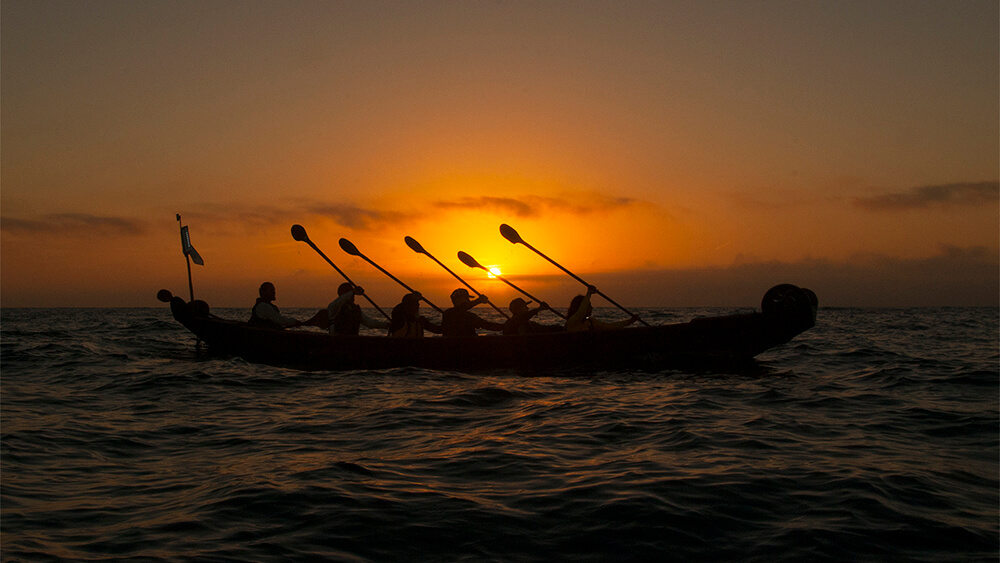Full Circle Chumash Cross Channel in Tomol to Santa Cruz Island

The coastal portion of our indigenous homeland stretches from Morro Bay in the north to Malibu Point in the south, and encompasses the northern Channel Islands of Tuqan, Wi'ma, Limuw, and 'Anyapakh (San Miguel, Santa Rosa, Santa Cruz, and Anacapa). This great, elongated bowl with its irregular rim of coastal mountain contains and nurtures a breathtaking array of maritime habitats. The ancestors of the autochthonous people of the regionâwe are now known as Chumashâwere so well-integrated into and adapted to their habitats that they were able to thrive here continuously and sustainably for some thirteen thousand years before European contact.
As for many indigenous maritime cultures, the canoe is central to our understanding of who we are as a people on this specific place on the earth. Until the missionization of the Chumash people, our waters were filled with watercraft, especially the redwood plank canoe, the tomol, among the most advanced technological achievements of North America's indigenous peoples. Used for both fishing and transportation, these elegant and versatile canoes wove together coastal and island communities in a complex system of trade, kinship and a resource stewardship that was sustained over thousands of years.
The old Brotherhood of the Canoe governed the manufacture and use of the tomols until it was formally disbanded around 1834 because of the decimation of the people and the tomols. However, 142 years later, in 1976, Helek (Peregrine Falcon) was the first tomol to be built in modern times. Her design based on ethnographic and historic accounts as well as archeological data, she was paddled by a crew comprised of ten members of the modern Brotherhood of the Tomol from Tuqan to Wi'ma and then to Limuw in a grueling and much-celebrated journey.
The tomol, 'Elye'wun (Swordfish), was built by the Chumash community in 1996-97 under the leadership of the Chumash Maritime Association. On September 8, 2001, 'Elye'wun made her first and historic crossing from the mainland to Limuw, completing the island circle begun by Helek. This crossing culminated in a cultural celebration with about 150 Chumash families and friends encamped on the island, marking the first time for almost all of us to make this return to an important origin place of our people.
On September 11, 2004, 'Elye'wun again made the arduous journey from mainland to the village of Swaxil (at the present day location of Scorpion Valley) where some 200 Chumash and other Native people were gathered to discuss issues affecting Sacred Sites. The 2004 crossing was truly a milestone for the community in that the crew landing 'Elye'wun were five Chumash youths aged 14 to 22, marking a significant passing on of knowledge and experience to our young people. These are part of the generation who are now accustomed to the awesome sight of a traditional canoe in our home waters, giving some of us older ones-who did not even know to hope for such a thing in our own youth!-a profound sense of accomplishment and satisfaction.
As with other coastal indigenous nations, Chumash people are restoring our heritage of intimacy with the sea for the dual purpose of protecting her and as a means of rediscovering our dignity and identity as a people sprung from this place. Against overwhelming odds, what we are seeing is a cultural spirit so compelling that the tree once considered dead has sent up strong, resilient shoots and branches. The resurgence of the canoe is but one example, but one that stands as an icon for what is happening in the hearts of many Chumash people as we strengthen the knowledge of our heritage.
The 2004 Crossing was jointly sponsored by Barbareño Chumash Council and Chumash Maritime Association with funding from Seventh Generation Fund and others. Special thanks are due to Jack Byer and support vessel Just Love; Bob Duncan and support vessel Jack Tar; Channel Islands National Marine Sanctuary's Chris Mobley and Bob Schwemmer for support vessel Xantu and camera; Ed Cassano, friend and skipper par excellence; Channel Islands National Park's Ann Huston and especially staff at Scorpion Campground.
'Elye'wun's 2004 crew: Perry Cabugos (Captain), Marcus Lopez (Captain), Michael Cordero, Roberta Cordero, Michael Cruz, Tom Lopez, Rick Mendez, Oscar Ortiz, Reggie Pagaling, Alan Salazar, Jacqueline Scheinert, Steve Villa, Mati Waiya. The Landing Crew: Marcus V. O. Lopez (Captain), Tano Cabugos, Diego Cordero, Jimmy Joe Navarro, Michael Sanchez
Bibliography
Cordero, J.,"Like I'd Been There Before, The Tomol Brings Her People Back into Balance," News from Native California, 1998, Vol 2, No. 3, pp. 7-12.
Cordero, R., "Our Ancestors' Gift Across Time, A Story of Indig enous Maritime Culture Resurgence, News from Native California, 1998, Vol 2, No. 3, pp. 4-6.
Cordero, R. and G. Sanchez, "Full Circle, Chumash peoples gather on Santa Cruz Island to celebrate a historic tomol crossing of the Santa Barbara Channel," News from Native California, 2001, Vol 15, No. 2, pp. 10-15.
Hudson, T., "At Sea with the Helek," The Masterkey, 1977, pp. 59-65.
ed., Hudson, T., J. Timbrook and M. Rempe, Tomol: Chumash Watercraft as Described in the Ethnographic Notes of John P. Harrington, 1978, 190 pp.
Wilkinson, C., Messages from Frank's Landing: A Story of Salmon, Treaties, and the Indian Way, 2000, 118 pp.

